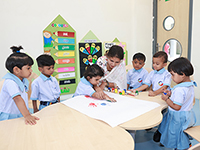Have you ever watched a child learn to ride a bike? A firm hand will provide support at first. Slowly, it will be removed as the child gets confidence.
That’s exactly how scaffolding in teaching works. It is a method of teaching that introduces concepts to students through step-by-step guidance. As students receive such a systematic direction, they become more engaged. Read on to learn all you need to know about scaffolding in education and why it’s a better option for classrooms.
What is Scaffolding?
Scaffolding in teaching is a systematic process of guiding students toward understanding complex concepts through step-by-step guidance. This method, developed by psychologist Jerome Bruner, relies on Vygotsky’s Zone of Proximal Development (ZPD)–the space between what an individual can do alone and what they can do with support.
Types of Scaffolding Strategies
Take a look at some of the different teaching methods in scaffolding:
- Modelling and Demonstration: First, teachers demonstrate a concept. That makes them learn the problem-solving processes before they attempt to do them individually.
- Visual Aids: It is the process of using charts and diagrams to enable students to visualise intricate concepts. Visual aids work really well when comparing two concepts.
- Questioning: Guided and open-ended questioning is a great way to make the students think for themselves and see how different concepts are related to each other. Some of the top schools in Nagpur make use of Socratic questioning to improve engagements.
- Chunking Information: A type of Scaffolding strategy where complex topics are broken down into small units to avoid cognitive overloading.
- Peer Learning: It is a method of pairing students with peers who can offer guidance on the topic.
Benefits of Scaffolding
Scaffolding is an instructional strategy that gives students an appropriate amount of support until they are able to learn on their own. It helps to establish confidence by giving help where required. When students get organized guidance, they are more active and interested in facing challenges.
Yet another highlight is its versatility. For instance, scaffolding methods assist early literacy and problem-solving skills in nursery admission programs. It breaks down complex tasks into easy steps.
As students progress with ongoing guidance, they begin to think and solve problems independently. That works well in mixed-ability classrooms, where every pupil can have individualised support based on their specific learning requirements.
If done effectively, scaffolding might make miracles. Let us discuss a case study. Dirk is a professor at Maastricht University. Once, he experimented with the approach of lowering the dropout rate for first-years. The results were just awesome, particularly for struggling students.
Also Read: The importance of Co-curricular activities at Bangalore International School
Step-by-step Guide To Implement Scaffolding in the Classroom
Have a look at how teachers implement scaffolding in teaching:
- Evaluate Previous Knowledge: Teachers, first of all, will check the existing knowledge levels of all students through an interactive session. That’s done to calculate the amount of support they need.
- Set Clear Learning Objectives: Determine what the students should know at the conclusion of the lesson. The objectives must be specific and measurable.
- Build on What They Know: Always try to link new concepts to familiar ones. If students are learning about multiplication, tie it to repeated addition. Connecting lessons to everyday life also gives learning context.
- Provide Step-by-Step Instructions: Never overload young minds with a lot of information. Teachers must present the information in small parts. Instructors can make use of visual cues to prevent students from getting lost.
- Stimulate Student Interaction: Lively discussions can get students thinking for themselves. As they teach others, it cements their understanding.
- Track Progress and Adapt Support: Teachers must pay close attention to students to question them in a way that prompts deeper thinking. At each stage, adapt their level of support depending on whether students are picking up the concepts.
- Give Constructive Feedback: Instructors are required to provide feedback to students on how to do better. They may ask reflective questions such as “What made this challenging?” or “How did you arrive at this conclusion?” to promote deeper thinking.
Role in Personalised Learning
Scaffolding methods offer an individualized learning chance to every student. The process acknowledges that all learners are different and learn at his or her own pace. It provides a flexible system where teachers can adjust their support based on each learner’s pace.
Many of the best play schools in Nagpur utilise such instructional strategies to create a student-friendly learning environment. They will begin with some basic tasks. As the children become more familiar, teachers will introduce more complex tasks.
Conclusion
Scaffolding is indeed really helpful for students struggling with tough curriculum structures. It offers support when needed to raise their confidence levels.
We at GIIS follow scaffolding in teaching so as to make sure that students get the required support at each stage. Our structured approach will improve student engagement at all levels. Let’s create a positive learning environment for your child!

 Nagpur Campus
Nagpur Campus

















